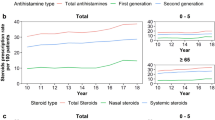Abstract
We undertook this survey about the use of clarithromycin in the Ear, Nose, and Throat (ENT) Outpatient Department of Fudan University Hospital to understand its utilization patterns and rational use. A survey of prescriptions given to outpatients was carried out, and detailed information of the patients, including age, sex, diagnosis, combined medication, and other information, was recorded in Excel spreadsheets. The rationale for each prescription was evaluated retrospectively. Based on our analysis, 82.5% of the clarithromycin prescriptions were for the treatment of rhinosinusitis. It was found that the parameters for the diagnosis of this condition were surprisingly broad and should have been more specific. In addition, the clarithromycin dosage regimen varied in clinical practice. For chronic rhinosinusitis, the duration of treatment was between 8 and 16 days, which was not sufficient. Moreover, clarithromycin was prescribed along with considerable numbers of pharmacotherapeutic anti-allergic drugs. Our survey indicated that improvements in the quality of clarithromycin prescriptions in otolaryngology outpatients should be made. Furthermore, the importance of medical education to patients should be emphasized. In addition, the interaction between clarithromycin and other anti-allergic drugs requires further investigation.
Similar content being viewed by others
References
World Health Organization (WHO) (2011) Antimicrobial resistance and its global spread. http://www.who.int/world-health-day/en/index.html. Accessed 27 Sep 2016
Xiao Y, Zhang J, Zheng B et al (2013) Changes in Chinese policies to promote the rational use of antibiotics. PLoS Med 10(11):1–4. doi:10.1371/journal.pmed.1001556
Shimizu T, Suzaki H (2016) Past, present and future of macrolide therapy for chronic rhinosinusitis in Japan. Auris Nasus Larynx 43(2):131–136
Fokkens W, Lund V, Mullol J et al (2007) EP3OS 2007: European position paper on rhinosinusitis and nasal polyps 2007. A summary for otorhinolaryngologists. Rhinology 45(2):97–101
Shi Z-l, Peng H, Xian-Wei H et al (2014) Effectiveness and safety of macrolides in bronchiectasis patients: a meta-analysis and systematic review. Pulm Pharmacol Ther 28(2):171–178
Korkmaz H, Ocal B, Tatar EC et al (2014) Biofilms in chronic rhinosinusitis with polyps: is eradication possible? Eur Arch Otorhinolaryngol 271(10):2695–2702
Health Department of China (2007) Prescription administrative policy. http://www.gov.cn/flfg/2007-03/13/content_549406.htm. Accessed 22 Sep 2016
Harmes KM, Blackwood RA, Burrows HL et al (2013) Otitis media: diagnosis and treatment. Am Fam Phys 88(7):435–440
Vlastarakos PV, Manolopoulos L, Ferekidis E et al (2008) Treating common problems of the nose and throat in pregnancy: what is safe? Eur Arch Otorhinolaryngol 265(5):499–508
Hare KM, Grimwood K, Chang AB et al (2015) Nasopharyngeal carriage and macrolide resistance in Indigenous children with bronchiectasis randomized to long-term azithromycin or placebo. Eur J Clin Microbiol Infect Dis 34(11):2275–2285
Gao YP, Liu HQ, Liu HY et al (2012) Medication compliance analysis of adult chronic rhinosinusitis. J Clin Otorhinolaryngol Head Neck Surg (China) 26(05):224–225
Fan Y, Xu R, Hong H et al (2014) High and low doses of clarithromycin treatment are associated with different clinical efficacies and immunomodulatory properties in chronic rhinosinusitis. J Laryngol Otol 128(03):236–241
Niedrig D, Maechler S, Hoppe L et al (2016) Drug safety of macrolide and quinolone antibiotics in a tertiary care hospital: administration of interacting co-medication and QT prolongation. Eur J Clin Pharmacol 72(7):859–867
US Food & Drug Administration (2011) FDA Drug Development and Drug Interactions: Table of Substrates Inhibitors and Inducers. http://www.fda.gov/Drugs/DevelopmentApprovalProcess/DevelopmentResources/DrugInteractionsLabeling/ucm093664.htm#4. Accessed 27 Sep 2016
Carr RA, Edmonds A, Shi H et al (1998) Steady-state pharmacokinetics and electrocardiographic pharmacodynamics of clarithromycin and loratadine after individual or concomitant administration. Antimicrob Agents Chemother 42(5):1176–1180
Author information
Authors and Affiliations
Corresponding author
Ethics declarations
Conflict of interest
We declare that we have no conflicts of interest.
Ethical approval
All procedures performed in this study involving human participants were in accordance with the ethical standards of the institutional research committee and with the 1964 Helsinki declaration and its later amendments or comparable ethical standards. The Ethics Committee of Shanghai Eye, Ear, Nose and Throat Hospital, Shanghai Fudan University, Shanghai, China, approved this study.
Rights and permissions
About this article
Cite this article
Yan, J., Shen, J., Li, Y. et al. Survey about the use of clarithromycin in an ENT outpatient department of a tertiary hospital. Eur Arch Otorhinolaryngol 274, 3103–3107 (2017). https://doi.org/10.1007/s00405-017-4607-7
Received:
Accepted:
Published:
Issue Date:
DOI: https://doi.org/10.1007/s00405-017-4607-7




